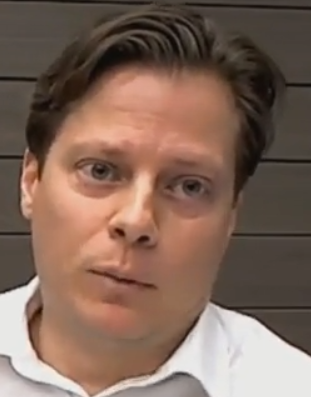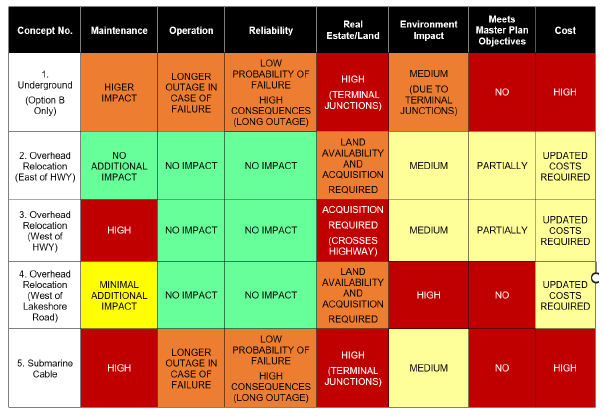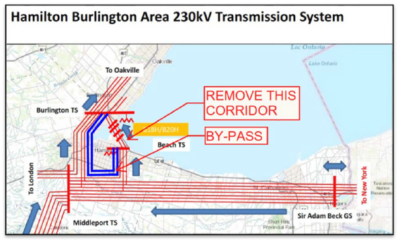 By Staff
By Staff
October 18th, 2023
BURLINGTON, ON
On July 13, 2022, Regional Council endorsed staff to identify an overhead relocation option for the hydro towers between Lakeshore Road and Eastport Drive; and that a detailed feasibility analysis be conducted on this option.
Staff from Halton Region, City of Burlington, Conservation Halton and Hydro One Networks Inc. have continued work on assessing options relating to the Hydro Towers. The detailed analysis has concluded that no above ground relocation options have been identified as feasible.

Hydro towers along the Beachway are going to be in place for a long time.
An underground alignment is the only relocation option remaining that could meet the objective to relocate the towers, although there would be significant impacts to some Master Plan features.

Rory Nisan
The underground alignment option would result in removing nine towers along the beach by relocating the transmission line underground, however the cost to relocate the existing towers to underground is significant and substantially more than the overall park master plan implementation costs. As a result staff recommend that this option no longer be pursued.
Burlington Ward 2 resident Rory Nisan, representing ward 3 residents, commented that a possible option would be to move the towers to the Hamilton Harbour area.
Hydro Tower Relocation Options and Technical Report Summary
The consultant retained to conduct a preliminary technical review of the various hydro tower relocation options has advanced six different options from ‘sketch’ to ‘preliminary plan’ in order to better inform discussions and next steps in this initiative. The technical assessment reviewed each option from a variety of perspectives including technical feasibility; impact to the power grid; safety; environmental impacts; estimated capital cost; construction feasibility; regulatory considerations; and real estate availability.
Graphics on each of the options are set out at the end of this article.
This level of detail was vital to understanding the spatial requirements of each option, and gaining a better understanding of how the options could impact the natural environmental and implementation of the features identified in the 2015 Master Plan.
Following the completion of the Preliminary Technical Report, project partner staff (Hydro One, Halton Region, City of Burlington and Conservation Halton) held a workshop to review the results and identify, based on the technical components, which options were feasible for continued consideration.
Six Options Investigated: Technical Feasibility Summary
Option 1: Underground
The consultant’s report explored two potential underground alignments.
The primary challenge associated with any underground option relates to the requirement of additional infrastructure (terminal junctions) which are necessary to transition the existing overhead system to an underground system. Two, 70 metre by 70 metre terminal junctions at the north and south end of Beachway Park would be required to transition the overhead system to an underground system. The addition of terminal junctions at either end of the park would create new unintended visual impacts within the park and would limit implementation of the features of the Living Shoreline character area as envisioned in the 2015 Master Plan. The cost estimates for this option exceed the budget currently allocated for this project.
While the underground option has been Council’s preferred option to explore, this option results in major changes to the Living Shoreline character area and also has significant cost implications. This option is feasible from a technical perspective.
Option 2: Overhead Relocation East Side of Eastport Drive / QEW
Option 2 proposes to relocate six tower structures westward to the east side of Eastport Drive. The key challenge associated with any option to relocate towers is the presence of existing structures or infrastructure in the area. Through discussion with Project Partners it was clarified that in order to meet operational requirements (i.e., to facilitate access to overhead transmission lines requiring repair in case of service interruption) land below new transmission lines is required to be unencumbered by existing structures. Locating the transmission line in proximity to Eastport Drive also creates challenges with respect to maintaining Ministry of Transportation setback requirements from Eastport
Drive and the Queen Elizabeth Way. Option 2 also faces challenges in terms of finding vacant land that would also result in a viable design from a technical perspective. Option 2 is not feasible from a technical perspective.
Option 3: Overhead Relocation West Side of QEW
Option 3 proposes to relocate a portion of the transmission line to the west side of the Queen Elizabeth Way. As with Option 2, the key challenge relates to the presence of existing structures or infrastructure in the area, in this case, crossing a Provincial highway has been identified as a significant barrier. It would necessitate highway closures in the event repairs are required, or other safety risks. On the basis that the resulting alignment does not meet operational and technical requirements, Option 3 is considered not feasible.
Option 4: Overhead Relocation within the Park
Option 4 proposes to relocate the transmission line slightly westward on the backside of the existing dunes. Implementation of Option 4 would result in substantial negative impacts to the natural environment (dune) and would significantly limit Halton Region’s ability to enhance the park with the features identified in the 2015 Master Plan. Further, the resulting alignment does not respond to Regional Council’s objective to minimize the visual impact of the transmission line, given that the transmission line will remain visible within Beachway Park. Given that the resulting alignment does not respond to Regional Council’s objective to minimize the visual impact of the transmission line and will serve to undermine objectives to protect and enhance the natural heritage system, the Project Partners recommend not moving forward with consideration of Option 4.
Option 5: Submarine Cable
Option 5 proposes to remove the tower structures and install a transmission line cable on the lakebed. As with Option 1, two, 70 metre by 70 metre terminal junctions would be required to transition the overhead system to an underground system, along with the addition of three to five lattice towers, creating new visual obstructions within the park. In addition, it was identified that submarine cables have a shorter overall estimated asset life, by as much as half, even when properly maintained. Further, regulatory complexities associated with Option 5 would result in a lengthy approval and implementation process. The Project Partners recommend not moving forward with consideration of Option 5.
Option 6: Enhancement
Option 6 suggests that the transmission line and towers to remain in situ, with visual enhancements added to the towers. Although Option 6 would not address Regional Council’s objective to minimize the overall visual impact of the transmission line, the option does provide an opportunity to improve the appearance of towers. Given that Option 6 would not result in a lessened visual impact, Project Partners recommend not moving forward with Option 6.
Impact Matrix of the 6 Options Explored in the Technical Report:

In order to ensure a broad range of options and opportunities have been explored, the consultant retained to provide commentary on the potential to have the transmission line removed from Beachway Park area entirely through alternate means, by removing and relocating the existing transmission line and towers around Hamilton as shown in Figure 1, below. The challenges associated with each of these options are outlined below.
Bypass Option
The Consultant identified that there is a strong likelihood that the majority of the existing towers cannot handle additional overhead circuits; therefore, an additional transmission line system will be required to carry the existing four circuits. Relocating the transmission lines around Hamilton would be very costly due to the transmission line’s total length. The existing 115kV lines from Beach Transformer Station to Burlington Transformer Station around the City of Hamilton are approximately 23 kilometres. The existing 230kV lines between Beach Transformer Station and Burlington Transformer Station, which run west of Hamilton via Middleport Transformer Station, are over 40 kilometres long.

Hamilton Burlington Area Transmission System
Based on the capital cost estimates completed for Concepts 2, 3, and 4, the average cost to install 2.3 kilometres of a new transmission line system was estimated to be approximately $23 million. This equates to $10 million per kilometre. Based on the approximate unit rate of $10 million per kilometre, assuming an overhead transmission line throughout, the base implementation costs would be $230 million for the 115kV Line bypass and $400 million for the 230kV Line bypass. This cost does not include the value of real estate procurement costs that would be required to widen existing rights-of-way that have been in place for decades and are generally surrounded by developed land.

























Shocking. This was not even given a sniff before the grand design phase as its the only major impediment to developing the entire project.
Has anyone else noticed that the 2015 Beachway Park Master Plan has made absolutely no progress at the waterfront in what is now eight years after the plan? Yes, the Region has spent a bunch of money (more than budgeted per property) to buy and tear down some more homes along the beach, but this was inevitable.
Taking away the hydro towers has always been a “nice to have” wish to improve the view, but in actual fact it is not a “need to have” item by any stretch of the imagination. And now the true costs in dollars and impacts on the park of all of the concepts have been studied to death and revealed to be the pipe dreams they were eight years ago and still are. When you have to prove the obvious it always reveals poor management and decision-making.